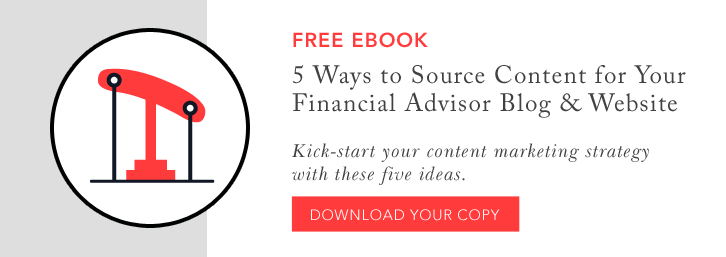Top 5 Biggest Blogging Mistakes Financial Advisors Make
Blogging is a great way to reach out to your clients and potential clients. A blog is the perfect companion for financial advisor websites. When you regularly publish blog posts, you can become a resource of information, discuss current events and market trends, and share information about your advisory business— all in an effort to retain and grow your client base. Whether you’re new to blogging, or have been at it for a while, making blogging mistakes can be avoided by learning from these 5 tips:
Don’t Get Too Technical
As a financial advisor, you’re an expert in your field. This means you know a great deal more about investing and money management than your average blog post reader. And while that means you’re a great resource for information, it’s important to remember to speak in terms that aren’t too technical for the average reader. Use easy-to-understand explanations of topics rather than getting too technical or in-depth.
Keep the content fairly generic, when possible. The best blog content will have enough information and tips to be useful, but not so much information that the readers think that they could just do it themselves. Your content should leave the reader wanting to reach out to you for more, basing that on the information you were able to provide and the way in which you deliver that content. Coming off as too technical can be the opposite as friendly and approachable, which are qualities that can sway potential clients when deciding on a financial advisor.
It’s Not All About You
Having a professional blog is not just a platform to talk about yourself and your business – it’s meant to be a channel for communicating with your clients and potential clients. It’s also not a place to post too many details about your personal life or what you did for fun on the weekend.
People are coming to your blog to either get a question answered or learn more about a financial topic. When you get questions from clients, you can turn your response into a blog post. Or perhaps you have the same questions that are frequently asked by new clients or potential clients seeking your services.
If that’s the case, you can answer those FAQs (Frequently Asked Questions) in a series of blog posts or one long-form blog post. You can share that post frequently and/or “pin” it to the top of your blog page.
If your compliance team approves of allowing comments to be turned on for your blog posts, you may get questions asked in your comments. Or you can post an email address for any questions that your readers have. This can be a great resource for content creation on your end, which directly answers a question from the audience and further solidifies your place as a resource of financial information.
Don’t Ignore Your Blog – Keep a Calendar
Running a blog is a marathon, not a sprint. The worst thing you can do is start out by posting very frequently and then over time you either slow down or stop blogging all together. The best way to prevent this is by using a content calendar or editorial calendar for your blog. By keeping a calendar (and holding yourself to it) you can thoughtfully curate content that is relevant and even seasonal. As with any industry, the financial industry has “seasons” where you may be busier than other times, or where certain types of clients come in. (i.e. teachers in the summer, etc.) Think about how your business may be seasonal and add blog post topics to your calendar that align with these times of the year.
Having a calendar is also useful when you have extra time. With all of your posts planned out, you can write blog posts ahead of time when you find yourself feeling particularly inspired or happen to have the time available. This can help you keep your blog updated during extremely busy times when you know you won’t be able to write new posts.
Don’t Forget About SEO
One of the most important benefits of a blog is to use it for SEO purposes. SEO (Search Engine Optimization) is what search engines use to determine how they display search results. The more relevant content you have in relation to common search terms—including keywords and meta descriptions—the more likely your content will show up in an internet search. Without becoming an SEO expert, just think about some of the common terms people use when searching for financial advising services, keeping in mind that those terms aren’t always technically correct.
Think like your target customer and create content around search terms that they may be using on the Internet to find relevant content that could help them overcome an issue or concern.
The more focused your SEO efforts are, the higher liklihood that you will get more visitors to your site looking for specific content that will benefit them.
Don’t Forget to Generate Leads
Writing a blog can be a time-consuming part of your job, so it needs to provide the most return on your time and investment. Having a blog is important, and can be a great resource for leads, newsletter sign-ups and referrals.
At the very minimum, you should have a “contact us” link somewhere on the page. To take it a few steps further, you could sign up for a free analytics tool such as Google Analytics – or any other tool that allows you to monitor your blog page and the traffic it receives. You can then see which types of posts perform best, and even how your blog readers are finding you (Google, your website, social media, etc.) If you have a monthly newsletter, this is a great place to add the sign-up link. Even if you don’t put out any regular correspondence, adding readers to your contact or mailing list is a great way to generate leads down the line. And finally, adding a forward link to your blog posts as well as social share links makes it easy for your readers to share your content with friends and on their social pages—thus giving your content more exposure.


